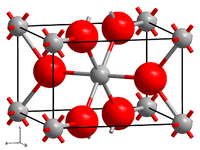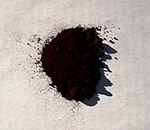Lead (IV) oxide
| Crystal structure | |||||||||||||||||||
|---|---|---|---|---|---|---|---|---|---|---|---|---|---|---|---|---|---|---|---|

|
|||||||||||||||||||
| __ Pb 4+ __ O 2− | |||||||||||||||||||
| Crystal system |
tetragonal (rutile type) |
||||||||||||||||||
| Space group |
P 4 2 / mnm (No. 136) |
||||||||||||||||||
| Lattice parameters |
a = 496 pm, c = 338 pm |
||||||||||||||||||
| Coordination numbers |
Pb: 6, O: 3 |
||||||||||||||||||
| General | |||||||||||||||||||
| Surname | Lead (IV) oxide | ||||||||||||||||||
| other names |
|
||||||||||||||||||
| Ratio formula | PbO 2 | ||||||||||||||||||
| Brief description |
brown to dark brown solid |
||||||||||||||||||
| External identifiers / databases | |||||||||||||||||||
|
|||||||||||||||||||
| properties | |||||||||||||||||||
| Molar mass | 239.2 g mol −1 | ||||||||||||||||||
| Physical state |
firmly |
||||||||||||||||||
| density |
9.4 g cm −3 |
||||||||||||||||||
| Melting point |
thermal decomposition: 290 ° C |
||||||||||||||||||
| solubility |
practically insoluble in water (0.14 mg l −1 at 25 ° C) |
||||||||||||||||||
| safety instructions | |||||||||||||||||||
|
|||||||||||||||||||
| As far as possible and customary, SI units are used. Unless otherwise noted, the data given apply to standard conditions . | |||||||||||||||||||
Lead (IV) oxide is a compound of the elements lead and oxygen with the ratio formula PbO 2 . It is a dark brown powder that has a strong oxidizing effect.
Occurrence
Of course, lead (IV) oxide occurs as a mineral plattnerite .
Extraction and presentation
Lead (IV) oxide is produced technically either by electrolytic oxidation or by chemical oxidation with strong oxidizing agents such as chlorine :
In the laboratory, the representation takes place via the oxidation of an alkaline lead acetate solution with hypochlorite:
properties
Physical Properties
Five modifications of lead (IV) oxide are known. They can be converted into one another through pressure and temperature changes. Up to a pressure of 4 GPa (at 200 ° C 1.3 GPa) lead (IV) oxide crystallizes in the tetragonal β-modification with a rutile structure . At higher pressures up to 7 GPa (at 300 ° C 6 GPa) the orthorhombic α-structure is present. The structure then changes to a cubic crystal system and corresponds to a defective fluorite structure. From 11.4 GPa the structure is orthorhombic and corresponds to that of zirconium dioxide . From 29 GPa an orthorhombic structure corresponding to the cotunnite is finally present.
Chemical properties
Due to the inert pair effect, α-PbO 2 is a strong oxidizing agent , with oxidation level 2 of oxidation level 4 being preferred.
When heated, it first converts into lead (II, IV) mixed oxide and above 550 ° C into
lead (II) oxide with elimination of oxygen .
use
Because of its high oxidizing power, lead dioxide is widely used both on an industrial scale and in the laboratory. It is used to make dyes . It is also used in fireworks , as an electrode in accumulators and for hardening sulfide polymers.
Lead (IV) oxide is used as a strong oxidizing agent in organic chemistry .
toxicity
Lead (IV) oxide is teratogenic , harmful and dangerous for the environment. In addition, it has been classified as carcinogenic for humans since 2006 (Category 2: "Substances that are to be regarded as carcinogenic for humans because sufficient results from long-term animal experiments or indications from animal experiments and epidemiological studies can be assumed to contribute contribute to cancer risk "). Lead (IV) oxide is classified in CH poison class 1 (very strong poisons).
Individual evidence
- ↑ a b c d P. D'Antonio: Powder Neutron Diffraction Study of Chemically Prepared β-Lead Dioxide , in: Acta Cryst., 1980, B36, 2394-2397, doi: 10.1107 / S0567740880008813 .
- ↑ a b c data sheet lead (IV) oxide (PDF) from Merck , accessed on January 19, 2011.
- ↑ a b c Entry on lead (IV) oxide in the GESTIS substance database of the IFA , accessed on December 7, 2019(JavaScript required) .
- ↑ Not explicitly listed in Regulation (EC) No. 1272/2008 (CLP) , but with the specified labeling it falls under the group entry lead compounds with the exception of those named in this annex in the Classification and Labeling Inventory of the European Chemicals Agency (ECHA), accessed on December 14, 2016. Manufacturers or distributors can expand the harmonized classification and labeling .
- ↑ Mineral Atlas: Plattnerite
- ↑ Georg Brauer: lead (IV) oxide . In: Handbook of Preparative Inorganic Chemistry . Ferdinand Enke Verlag, Stuttgart 1954, p. 571 f .
- ^ J. Haines, JM Léger and O. Schulte: The high-pressure phase transition sequence from the rutile-type through to the cotunnite-type structure in PbO 2 , J. Phys .: Condens. Matter 1996 , 8 , pp. 1631-1646. doi: 10.1088 / 0953-8984 / 8/11/009
- ↑ List of MAK and BAT values 2013, Communication 49, Senate Commission for the testing of harmful substances , Wiley-VCH Verlag , ISBN 978-3-527-67513-5 , July 2, 2013, doi: 10.1002 / 9783527675135.oth1 (freer Full text)
- ↑ IGS poison list ( page no longer available , search in web archives ) Info: The link was automatically marked as defective. Please check the link according to the instructions and then remove this notice. (PDF; 508 kB)







